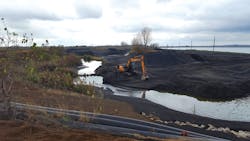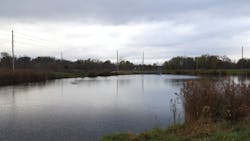A Treatment Approach to Managing Impoundment Waters
By Nathan Higgerson
When planning for closure of a coal combustion residual (CCR) pond at coal-fired power plants, there are several things to consider: the type of cover system, material stability and the water confined in or at the surface of the pond. Many of the issues affecting cost and schedule center around the water in the pond and how to remove it without causing problems for the current discharge water quality levels or becoming noncompliant with the facility’s National Pollution Discharge Elimination System (NPDES) permit.
The U.S. EPA issued a final rule (the “CCR Rule”) that regulates the disposal of CCR under Subtitle D of the Resource Conservation and Recovery Act. The CCR Rule, effective October 19, 2015, established minimum national criteria for continued operation of CCR surface impoundments. To comply with the CCR Rule, many facilities are closing their ash ponds within the time frame allowed by the rule.
Closure plans typically include removing standing water from the ash ponds to allow for grading and shaping the dewatered CCR surface.
Closure plans typically include removing standing water from the ash ponds, as well as partially removing “pore water” contained within the CCR, to allow for grading and shaping the dewatered CCR surface prior to placement of a final cap for ponds that are to be closed in-place. Water that has been in contact with CCR is commonly referred to as contact water or “dewaters.”
This article is based on a specific example of an analysis completed by Hanson Professional Services Inc. (Hanson) for a coal-fired generating facility pond system that requires an estimated 80 million gallons of surface and pore waters to be removed from the ponds prior to closure. The article details some of the water sampling, analytical laboratory results, hydraulic and concentration modeling and alternatives considered to demonstrate that the proposed short-term discharge of waters from the ash ponds will result in the continued attainment of water quality standards on an example site.
Sampling
A water sampling plan should be developed in order to identify the quality of water within the ash ponds. Grab samples should be collected from test pits excavated in the ash pond and from any wells installed in the ponds to characterize the surface and pore waters. Careful sampling techniques must be used to minimize sediment in the grab samples and provide representative samples for analysis. Grab water samples should also be collected from potential ponds or streams that may be used as receiving waters. The results will be used to determine how they could be affected by the proposed ash pond dewaters.
Based on the results of the sampling and the estimated volume of waters to be discharged, it is possible to calculate the estimated masses of each substance proposed to be discharged through the NPDES outfall to the receiving water. An antidegradation assessment can be performed to determine the total potential pollutant loading from the closure process and effects on the receiving water. For the purposes of such an assessment, substances in dewaters at concentrations less than the water quality standards are considered to be “protective” of the receiving water quality (i.e., would not cause degradation of the receiving water quality).
Case Example
Consider an example site that includes three fly ash ponds, a bottom ash pond, and two polishing ponds. The pond closure plan requires that the surface and pore waters in the fly ash ponds A, B and C and the site bottom ash pond be removed. To facilitate the surface and pore water removal for fly ash ponds A, B and C, a two-step approach is planned:
Step 1: Remove the “free” surface waters by pumping.
Step 2: Remove pore water to a level necessary to stabilize the ash surface by excavating several channels into the ponded fly ash. These channels will be excavated along the down-gradient perimeters of fly ash ponds A and B. These channels will facilitate the passive drainage of the majority of the surface waters, and some of the pore water, to dewater into fly ash pond C.
From fly ash pond C, the surface waters and pore waters will be pumped to the bottom ash pond, and then flow by gravity to polishing pond 1 then 2. Once the dewaters reach polishing pond 2, they can be monitored and released to the receiving waters after additional settling time.
In the example project, the representative average dewater concentrations of ammonia and total suspended solids (TSS) exceeded their respective effluent standards. The representative average concentrations in the combined waters from the next pond in sequence were considered in order to determine if water concentrations of ammonia and TSS would exceed the effluent standards. The process of examining the results of the waters as they pass through all the ponds was repeated for each pond until the waters reach the receiving waters.
The estimated combined volume of dewaters to be discharged from fly ash ponds A and B as part of the closure plan was estimated to be 80 million gallons. The waters were expected to be discharged over approximately 80 to 120 days, at a rate of approximately 0.5 MGD. The analysis demonstrated that the proposed short-term CCR dewatering discharge would contribute a negligible effect on receiving water concentrations.
Table 1 presents an excerpted list of the estimated mass of each substance to be discharged through the NPDES outfall from the ash pond dewatering activities (the “added load”). The table also estimates the predicted effects of discharging the pond surface and pore waters and demonstrates the proposed discharges would not exceed the water quality standards in the receiving water. The proposed discharges also would not contribute significant sedimentation or siltation after passing through polishing ponds 1 and 2. For some of the substances with exceedances, Hanson’s analysis demonstrated that the concentrations of the proposed dewaters’ discharges would be less than the existing receiving water concentrations.
Pollutant loading from the proposed dewatering would increase during the short-term discharges (about 80 to 120 days for the fly ash ponds). However, considering the demonstration presented in the table, discharges would not exceed water quality standards or contribute to causes of impairment in the receiving waters, and no adverse impacts to the existing uses of the receiving water are anticipated. Pollutant loading would decrease when the short-term dewaters’ discharges are completed.
Alternatives
Hanson considered management alternatives for the dewaters that could avoid or minimize an increase in pollutant loading to the receiving water. In addition to the assessment of potential degradation of receiving waters that could result from the dewatering discharges, an important criterion used in the alternatives analysis was the reliability of the time required to remove the dewaters from the ash ponds. The removal of the dewaters must be completed in a limited time frame to facilitate the regulatory-driven closure construction activities. Hanson considered passive and mechanical evaporation of the dewaters and using the dewaters for agricultural irrigation. However, these methods were not determined to eliminate the waters in acceptable, reliable time frames.
Hanson also evaluated using the CCR dewaters in power plant processes. The plant uses makeup water for various processes. However, the quality of the dewaters — including concentrations of TSS, total dissolved solids (TDS), metals and other substances — is such that it would not be usable without substantial pretreatment. The likely pretreatment processes would generate waste streams that would result in wastewater discharges for disposal. Because of the undesirable water quality and the time it would take due to the large volume of dewaters, it is not considered economically feasible to eliminate the estimated 80 million gallons of dewaters by using it in plant processes.
In this example, utilizing the existing treatment basins (bottom ash pond and polishing ponds) and NPDES outfall would leverage existing infrastructure and remove the dewaters in the shortest practicable timeframe for compliance.
Treatment processes to reduce pollutant concentrations in the dewaters’ discharges were also considered. Wastewater pretreatment processes could be installed at the outlet of fly ash pond A and at the bottom ash pond. Pretreatment processes including oxidation, precipitation, coagulation and flocculation would reduce the TSS in the dewaters and could reduce the dissolved concentrations of certain pollutants, such as iron and manganese. However, industry experience has shown that biological treatment, chemical precipitation or ion exchange processes are expensive and do not reduce all of the parameter concentrations, such as boron.
Specialized adsorption processes or reverse osmosis could be utilized to reduce the concentration of parameters including boron in the ash pond dewaters. However, these technologies are complex, expensive and generate solid and liquid waste streams that must be disposed of or treated. Considering the large volume of dewaters, it was predicted that the volumes of wastewaters from the pretreatment processes would be substantially large and concentrated, making these processes economically infeasible for the proposed short-term discharges of ash pond dewaters.
Conclusion
Discharging the dewaters through the existing treatment basins (bottom ash pond and polishing ponds) and NPDES outfall is consistent with the plant’s normal operation. This alternative would use the existing infrastructure at minimal additional cost and will remove the dewaters in the shortest practicable time to comply with the regulatory-driven closure time frames. The antidegradation assessment completed demonstrates that the dewaters can be discharged through the existing ponds and NPDES outfall without exceeding water quality standards. Discharging the dewaters through the existing ponds and NPDES outfall is the preferred alternative and was accepted by the state regulatory agency. IWW
About the Author: Nathan Higgerson serves as a power generation project manager and business development lead for Hanson Professional Services Inc. He brings 18 years of experience in the consulting and private industries for various power, civil, mining, environment and solid waste engineering projects.
Circle No. 149 on Reader Service Card




